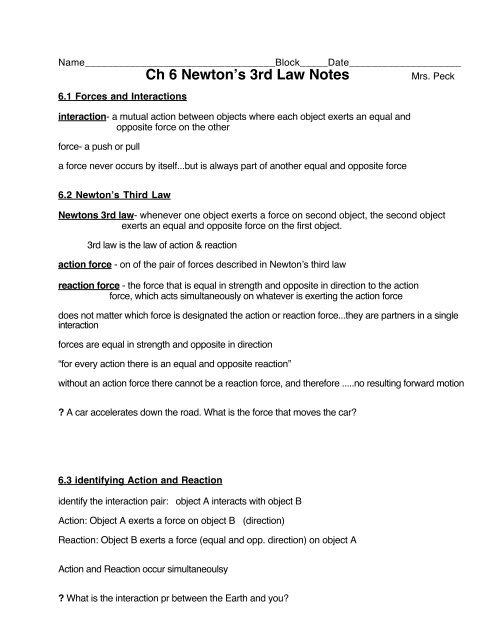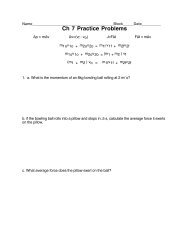Ch 6 Newton's 3rd Law Notes
Ch 6 Newton's 3rd Law Notes
Ch 6 Newton's 3rd Law Notes
Create successful ePaper yourself
Turn your PDF publications into a flip-book with our unique Google optimized e-Paper software.
Name__________________________________Block_____Date____________________<strong>Ch</strong> 6 Newton’s <strong>3rd</strong> <strong>Law</strong> <strong>Notes</strong>Mrs. Peck6.1 Forces and Interactionsinteraction- a mutual action between objects where each object exerts an equal andopposite force on the otherforce- a push or pulla force never occurs by itself...but is always part of another equal and opposite force6.2 Newton’s Third <strong>Law</strong>Newtons <strong>3rd</strong> law- whenever one object exerts a force on second object, the second objectexerts an equal and opposite force on the first object.<strong>3rd</strong> law is the law of action & reactionaction force - on of the pair of forces described in Newton’s third lawreaction force - the force that is equal in strength and opposite in direction to the actionforce, which acts simultaneously on whatever is exerting the action forcedoes not matter which force is designated the action or reaction force...they are partners in a singleinteractionforces are equal in strength and opposite in direction“for every action there is an equal and opposite reaction”without an action force there cannot be a reaction force, and therefore .....no resulting forward motion? A car accelerates down the road. What is the force that moves the car?6.3 identifying Action and Reactionidentify the interaction pair: object A interacts with object BAction: Object A exerts a force on object B (direction)Reaction: Object B exerts a force (equal and opp. direction) on object AAction and Reaction occur simultaneoulsy? What is the interaction pr between the Earth and you?
26.4 Action and Reaction on Different MassesAcceleration = force Newton’s 2nd <strong>Law</strong> of Motion acc. ~ 1mass massFor an interaction pair:The forces (both action and reaction) are equal and opposite in directionThe masses are different and inversely proportional to accelerationA given force exerted on a small mass produces a greateracceleration than the same force exerted on a large mass.if one of the masses were extremely large compared to the other, itsacceleration would be imperceptible.? Apply Newton’s third law to a tug-of-war. If the action is you pullling on the rope, is the reactionforce the ground pushing back on you or your opponents pulling back on the rope?6.5 do Action and Reaction Forces Cancel? (not necessarily)If action and reaction forces are internal to a system, they cancel each other and produce noacceleration of the system.Action and reaction forces do not cancel each other when either is external to the system beingconsidered.Fig 6.10 consider the orange as a separate system and the apple is external to that system.1. The apple pulls on the orangethis force affects the orange and causes it to accelerate toward the apple2. the orange pulls back on the apple w/ = & opp force (which is external to the system)this force affects the apple but not the orange
















